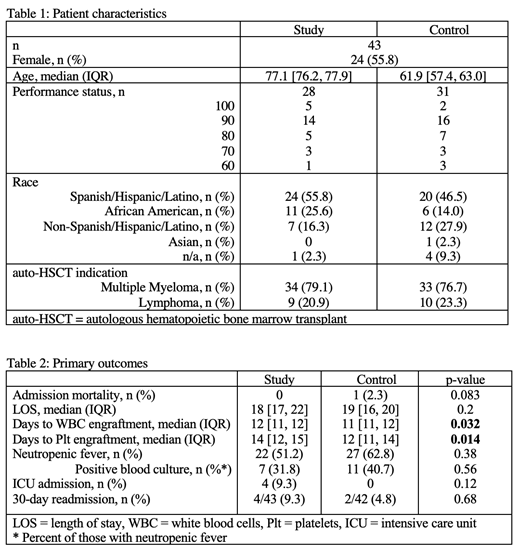Abstract
Background:
Autologous hematopoietic stem cell transplant (auto-HSCT) is a commonly used treatment for multiple myeloma (MM) and for relapsed/refractory non-Hodgkin lymphomas (NHL) for patients who are <65 years old. However, the majority of new diagnoses of MM and NHL are in patients >65 years old, and nearly half of those are in patients >75 years old. While some studies have evaluated the use of auto-HSCT in older patients 65-75 years of age, there are few studies evaluating the relative safety of this treatment in patients above the age of 75 years. Such patients and their providers require outcome data of auto-HSCT in the elderly in order to help guide informed decision-making.
Methods:
We conducted a retrospective cohort study comparing short-term outcomes for auto-HSCT in patients >75 years old and 55-65 years old for the diagnosis of MM or NHL, who were conditioned with either melphalan or BEAM (carmustine, etoposide, cytarabine, melphalan) respectively.
To identify patients, we used an internal database of auto-HSCT performed between 2005 - 2021. The study group included patients >75 years old. The control group included patients 55-65 years old that were matched to the study group patients by sex and time of transplant. Medical records were reviewed to gather data on demographics, pre-transplant functional status, transplant indication and conditioning regimen, length of stay, admission mortality, 30-day rehospitalization rate, ICU admission, neutropenic fever and infectious workup results, and time to WBC and platelet engraftment.
The primary outcomes of the study were admission mortality, length of stay, time to WBC and platelet engraftment incidence, incidence of neutropenic fever, positive blood culture, ICU admission, and 30-day rehospitalization rate.
Averages were calculated using medians and IQR. Admission mortality was evaluated using log rank test. P values were calculated using Fisher's test for categorical data and Wilcoxon rank sum test for continuous data. Significance was denoted by α =0.05.
Results:
We identified 43 patients aged >75 years old who underwent autologous stem cell transplant for multiple myeloma or lymphoma with melphalan or BEAM conditioning at Montefiore Medical Center between 2005-2021.
Patient characteristics (Table 1) The earliest transplant in out cohort was in 12/2005 and the latest was in 3/2021. The median time between transplants of patients in the study and cohort groups was 14 [7.5, 24] days. 24 (55.8%) patients were female. The median age in the study group was 77.1 [76.2, 77.9] years old and 61.9 [57.4, 63.0] years old in the control group. Both groups predominantly included patients from minority populations: 55.8 and 46.5% were Spanish/Hispanic/Latino and 25.6% and 14.0% were African American, in study and control groups respectively. Multiple myeloma was the most common indication for auto-HSCT.
Primary outcomes (Table 2) Admission mortality did not differ significantly between the groups, with only one death in the control group (p = 0.083). The length of stay was comparable at 18 [17, 22] days and 19 [16, 20] days (p = 0.2) for study and control groups, respectively.
Time to WBC engraftment in the study group was 12 [11, 12] days and 11 [11, 12] days in the control group (p = 0.032). Time to platelet engraftment in the study group was 14 [12, 15] days and 12 [11, 14] days in the control group (p = 0.014). Although both time to WBC and platelet engraftment was significantly longer in the study group, the clinical significance of this finding is questionable, especially as it did not seem to prolong length of stay.
There was no significant difference between incidence of neutropenic fever, or between incidence of positive blood cultures in patients with neutropenic fever. There was a non-statistically significant increase in the rate of ICU admissions in the study group vs control group 4/43 and 0/43 respectively (p=0.12). 30-day rehospitalization rate was comparable between the two groups.
Conclusion:
We did not find a statistically significant increase in morbidity or mortality for patients 75-80 years of age undergoing auto-HSCT compared with patients 55-65 years old. To our knowledge this is the largest cohort to date demonstrating the safety of auto-HSCT in this elderly population.
Gritsman: iOnctura: Research Funding. Shastri: Onclive: Honoraria; GLC: Consultancy; Kymera Therapeutics: Research Funding; Guidepoint: Consultancy. Verma: Medpacto: Research Funding; Curis: Research Funding; Eli Lilly: Research Funding; Stelexis: Consultancy, Current equity holder in publicly-traded company; Novartis: Consultancy; Acceleron: Consultancy; Celgene: Consultancy; Stelexis: Current equity holder in publicly-traded company; Throws Exception: Current equity holder in publicly-traded company; Incyte: Research Funding; GSK: Research Funding; BMS: Research Funding.


This feature is available to Subscribers Only
Sign In or Create an Account Close Modal